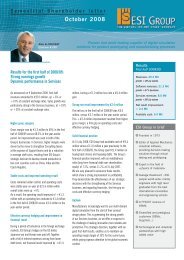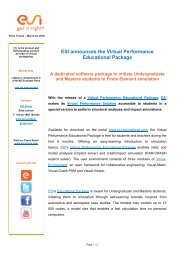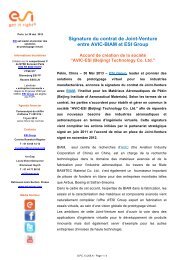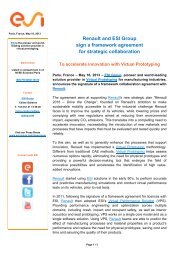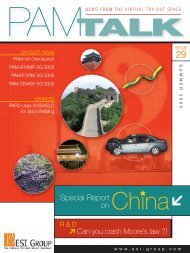PreCarBi consortium - ESI Group
PreCarBi consortium - ESI Group
PreCarBi consortium - ESI Group
You also want an ePaper? Increase the reach of your titles
YUMPU automatically turns print PDFs into web optimized ePapers that Google loves.
Project objectives<br />
The scientific aim of <strong>PreCarBi</strong> <strong>consortium</strong> was to develop new binder composite materials that<br />
allow pre-form designs to be manufactured and shaped under high temperature; or local tow<br />
reinforcement to be added under high temperature. This resulting research is considered an<br />
important contribution for advanced Liquid Resin Infusion (LRI) technologies to compete with<br />
expensive and complex pre-preg composite technologies.<br />
<strong>ESI</strong> GmbH was coordinator of this <strong>consortium</strong>. In addition, <strong>ESI</strong>’s major contribution to the project<br />
was forming, infusion and mechanical analysis of industrial aerospace applications manufacturing<br />
with the LRI technology.<br />
Description of the work<br />
The <strong>PreCarBi</strong> project took into account three principal materials:<br />
- New composite materials for bindered carbon yarns, developed by Tenax, in an iterative<br />
process to achieve the required performance;<br />
- Compatible resins, developed by Huntsman;<br />
- Converted new binder yarn composites into industrial preforms (Woven or Non-crimp<br />
Fabric) produced by Sigmatex and Airbus Operations GmbH.<br />
-<br />
Additional extensive materials characterization and testing work was performed by further research<br />
partners to assess and quantify improvements as the new materials were becoming available.<br />
From these efforts, <strong>ESI</strong> was then able to adapt PAM-QUIKFORM and PAM-RTM, simulation<br />
solutions for thermoforming and manufacturing of plastics and composites, to the industrial<br />
simulation of draping and LRI of binder yarn composites. Consequently, within the latter half of the<br />
project, industrial partners tested the new materials by applying them to selected industrial<br />
problems which are traditionally manufactured using only prepreg technologies. At this stage, a<br />
close collaboration between <strong>ESI</strong> and the industrial partners took place to help with numerical<br />
design and validate the industrial structures. Finally, the University of Patras worked on the<br />
development of cost analysis tools to help quantify the cost reductions over prepreg manufacturing.<br />
Page 2 / 4




